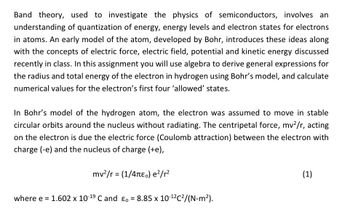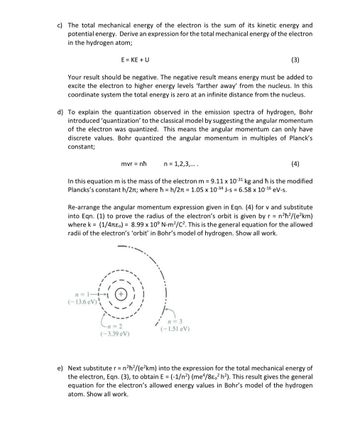
Chemistry
10th Edition
ISBN: 9781305957404
Author: Steven S. Zumdahl, Susan A. Zumdahl, Donald J. DeCoste
Publisher: Cengage Learning
expand_more
expand_more
format_list_bulleted
Concept explainers
Question
Solve questions d and e

Transcribed Image Text:Band theory, used to investigate the physics of semiconductors, involves an
understanding of quantization of energy, energy levels and electron states for electrons
in atoms. An early model of the atom, developed by Bohr, introduces these ideas along
with the concepts of electric force, electric field, potential and kinetic energy discussed
recently in class. In this assignment you will use algebra to derive general expressions for
the radius and total energy of the electron in hydrogen using Bohr's model, and calculate
numerical values for the electron's first four 'allowed' states.
In Bohr's model of the hydrogen atom, the electron was assumed to move in stable
circular orbits around the nucleus without radiating. The centripetal force, mv²/r, acting
on the electron is due the electric force (Coulomb attraction) between the electron with
charge (-e) and the nucleus of charge (+e),
mv²/r = (1/4π) e²/r²
where e = 1.602 x 10-19 C and Eo = 8.85 x 10-¹²C²/(N-m²).
(1)

Transcribed Image Text:c) The total mechanical energy of the electron is the sum of its kinetic energy and
potential energy. Derive an expression for the total mechanical energy of the electron
in the hydrogen atom;
(3)
Your result should be negative. The negative result means energy must be added to
excite the electron to higher energy levels 'farther away' from the nucleus. In this
coordinate system the total energy is zero at an infinite distance from the nucleus.
E = KE + U
d) To explain the quantization observed in the emission spectra of hydrogen, Bohr
introduced 'quantization' to the classical model by suggesting the angular momentum
of the electron was quantized. This means the angular momentum can only have
discrete values. Bohr quantized the angular momentum in multiples of Planck's
constant;
(4)
In this equation m is the mass of the electron m = 9.11 x 10-31 kg and ħh is the modified
Plancks's constant h/2; where ħ = h/2π = 1.05 x 10-34 J-s = 6.58 x 10-16 eV-s.
n=1-+
(-13.6 eV)
mvr = nh
Re-arrange the angular momentum expression given in Eqn. (4) for v and substitute
into Eqn. (1) to prove the radius of the electron's orbit is given by r = n²ħ²/(e²km)
where k= (1/4πeo) = 8.99 x 10° N-m²/C². This is the general equation for the allowed
radii of the electron's 'orbit' in Bohr's model of hydrogen. Show all work.
n = 1,2,3,....
-n=2
(-3.39 eV)
n=3
(-1.51 eV)
e) Next substitute r = n²ħ²/(e²km) into the expression for the total mechanical energy of
the electron, Eqn. (3), to obtain E = (-1/n²) (me4/8e02 h²). This result gives the general
equation for the electron's allowed energy values in Bohr's model of the hydrogen
atom. Show all work.
Expert Solution
This question has been solved!
Explore an expertly crafted, step-by-step solution for a thorough understanding of key concepts.
This is a popular solution
Trending nowThis is a popular solution!
Step by stepSolved in 2 steps with 2 images

Knowledge Booster
Learn more about
Need a deep-dive on the concept behind this application? Look no further. Learn more about this topic, chemistry and related others by exploring similar questions and additional content below.Similar questions
- Your doctor prescribed eye drops for you to treat a certain condition. You obtain the eye drop liquid medication in a small bottle containing a total volume 15 ml. Your instructions were to apply 2 drops in each eye at night. Given that the volume of 1 drop is 0.05 ml. Calculate many days will the eye drop liquid medication last?Key: start by calculating how many drops are present in 1 mlarrow_forwardHow do I calculate the volume I recorded with a 10 mL pipet?arrow_forwardan introduction on a research scientistarrow_forward
- A patient has a heart rate of 65 beats/min how many times does the patient hearts beat in 1 dayarrow_forwardName a specific scientific instrumentation or technological innovationthat is used in Organic Chemistry research laboratory. (Pharmacy setting)arrow_forwardEstimated volume of crucible 25.0 mL measured volume of crucible 23.0 mL percent error of estimate (% error=accepted value-experimental value/accepted value ) volume in (use measured volume of crucibleto answer for the ): kL cLarrow_forward
arrow_back_ios
arrow_forward_ios
Recommended textbooks for you
 ChemistryChemistryISBN:9781305957404Author:Steven S. Zumdahl, Susan A. Zumdahl, Donald J. DeCostePublisher:Cengage Learning
ChemistryChemistryISBN:9781305957404Author:Steven S. Zumdahl, Susan A. Zumdahl, Donald J. DeCostePublisher:Cengage Learning ChemistryChemistryISBN:9781259911156Author:Raymond Chang Dr., Jason Overby ProfessorPublisher:McGraw-Hill Education
ChemistryChemistryISBN:9781259911156Author:Raymond Chang Dr., Jason Overby ProfessorPublisher:McGraw-Hill Education Principles of Instrumental AnalysisChemistryISBN:9781305577213Author:Douglas A. Skoog, F. James Holler, Stanley R. CrouchPublisher:Cengage Learning
Principles of Instrumental AnalysisChemistryISBN:9781305577213Author:Douglas A. Skoog, F. James Holler, Stanley R. CrouchPublisher:Cengage Learning Organic ChemistryChemistryISBN:9780078021558Author:Janice Gorzynski Smith Dr.Publisher:McGraw-Hill Education
Organic ChemistryChemistryISBN:9780078021558Author:Janice Gorzynski Smith Dr.Publisher:McGraw-Hill Education Chemistry: Principles and ReactionsChemistryISBN:9781305079373Author:William L. Masterton, Cecile N. HurleyPublisher:Cengage Learning
Chemistry: Principles and ReactionsChemistryISBN:9781305079373Author:William L. Masterton, Cecile N. HurleyPublisher:Cengage Learning Elementary Principles of Chemical Processes, Bind...ChemistryISBN:9781118431221Author:Richard M. Felder, Ronald W. Rousseau, Lisa G. BullardPublisher:WILEY
Elementary Principles of Chemical Processes, Bind...ChemistryISBN:9781118431221Author:Richard M. Felder, Ronald W. Rousseau, Lisa G. BullardPublisher:WILEY

Chemistry
Chemistry
ISBN:9781305957404
Author:Steven S. Zumdahl, Susan A. Zumdahl, Donald J. DeCoste
Publisher:Cengage Learning

Chemistry
Chemistry
ISBN:9781259911156
Author:Raymond Chang Dr., Jason Overby Professor
Publisher:McGraw-Hill Education

Principles of Instrumental Analysis
Chemistry
ISBN:9781305577213
Author:Douglas A. Skoog, F. James Holler, Stanley R. Crouch
Publisher:Cengage Learning

Organic Chemistry
Chemistry
ISBN:9780078021558
Author:Janice Gorzynski Smith Dr.
Publisher:McGraw-Hill Education

Chemistry: Principles and Reactions
Chemistry
ISBN:9781305079373
Author:William L. Masterton, Cecile N. Hurley
Publisher:Cengage Learning

Elementary Principles of Chemical Processes, Bind...
Chemistry
ISBN:9781118431221
Author:Richard M. Felder, Ronald W. Rousseau, Lisa G. Bullard
Publisher:WILEY